Columbia and Peru 300 to 1534
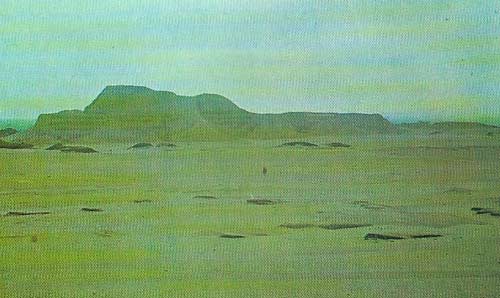
Figure 1. Millions of mud bricks were used to build the Temple of the Sun (or Sun Pyramid) and the neighboring Temple of the Moon at Moche, on the north coast of Peru. The Temple of the Sun formed the ritual heart of the Mochinca state during the first thousand years AD. Both palaces have suffered greatly from erosion and looting and the original form of the Sun Pyramid is now hard to discern.
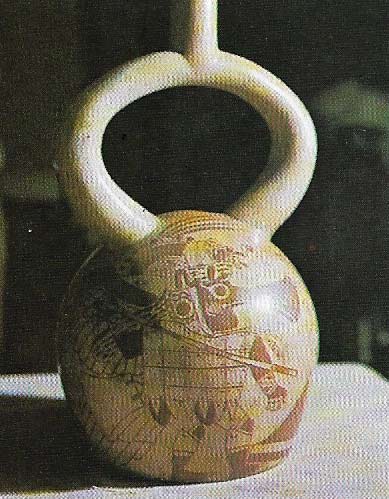
Figure 2. Stirrup-spouted pottery vessels were characteristic of the Mochica period in the first thousand years AD. These vessels were made by specialist potters. One type of vessel took the form of portrait heads, while another (an example of which is shown here) had plain, smooth bodies with painted designs. These often took the form of scenes from Mochica life and warriors on action. The spout shape changed subtly as centuries passed.
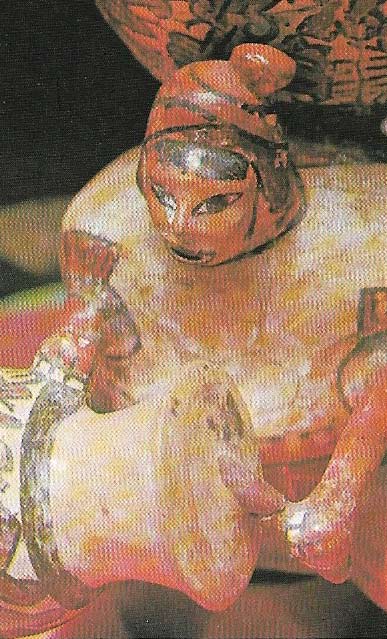
Figure 3. Nazca potters, renounced for the strong blocks of color that gave their work a cartoon-like effect, made this lifelike figure of a drummer. Nazca culture flourished in Peru at the same time as Mochica in the north.
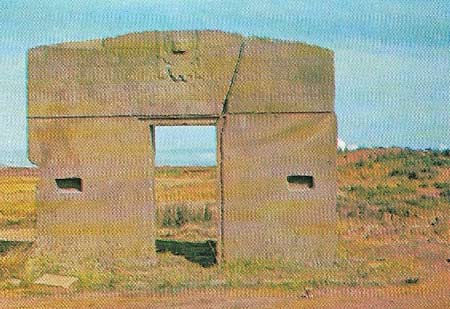
Figure 4. The Gate of the Sun, Tiahuanaco, Bolivia, is carved from a single block of stone and formed part of a great ceremonial enclosure. It is adorned with low-relief carving.
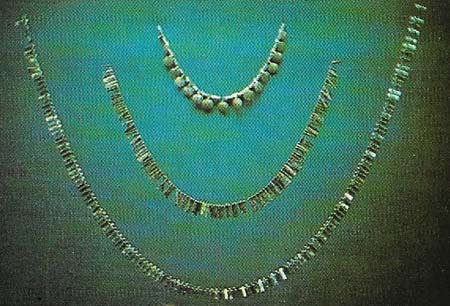
Figure 5. The art of gold ornamentation was highly developed in South America. The main centers of innovation were in Colombia and Ecuador, spreading northwards from there into Mexico.
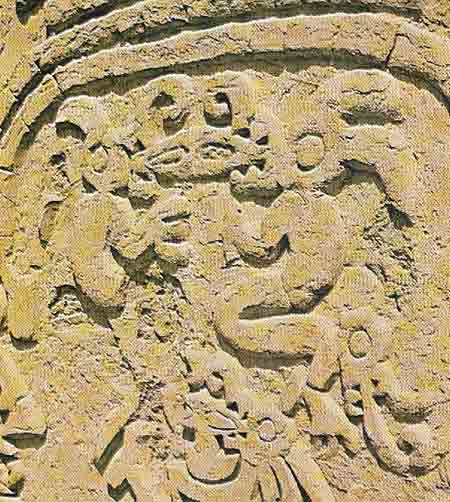
Figure 6. A restored panel of decoration in adobe – mud brick – forms part of the outlying temple of El Dragon at the site of Chan Chan, the ancient city north of Trujillo in the Moche Valley of northern Peru. Moche was an earlier focus of civilization in this valley, as the colonial and modern city of Trujillo was after Chan Chan. The site consists of a series of great walled enclosures, altogether covering some 28 square kilometers (11 square miles).
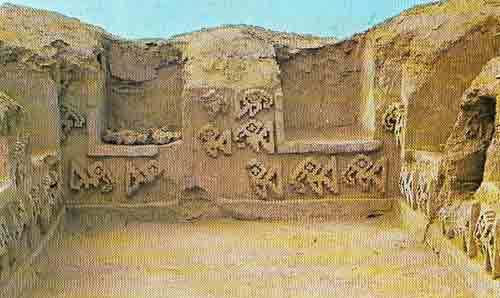
Figure 7. Molded adobe relief decorates the interior of a room at Chan Chan. The friezes are repetitive and constant of birds, fish or abstract designs. The rooms have niches in the walls and some have a U-shaped structure called an audiencia, which is thought to have been the seat of a clerk, who checked goods in and out.
In South America one area has always led the rise to civilization – that of the Andes from Lake Titicaca northwards to Panama, and their flanking Pacific and Amazon slopes. There the earliest pottery, the first signs of agriculture and the first settlements and public buildings have been found. From AD 300 onwards, after 1,500 years of increasing momentum, a number of regional cultures of a diverse character arose. They were so strongly regionalized in their art as to suggest separate political units, with strongholds attesting to warfare between them.
The arts of Colombia
In the far north of the South American continent, in present-day Colombia, a gold-working tradition of great technical competence and artistic originality emerged (Figure 5). Pendants and nose ornaments of sheet gold with added detail commonly survive, but there are also magnificent gold vessels for holding the drug coca and unique items such as the model raft with a god and his attendants in the Bogota Museo del Oro. Techniques extended from the simple hammering of sheet metal to granulation, lost-wax casting and the creation of a gilt surface on a gold-copper alloy by removing the copper with acids from plants.
In southern Colombia the monumental art of San Agustin flourished. The mounds in the area contain stone megalithic chambers, apparently both tombs and shrines, entered by stone tunnels decorated with painted designs. Huge blocks of the Volcanic rock andesite were worked into box-like sarcophagi, and shafts of rock turned into menacing statues of warriors and demons. Some of them were double figures, with an animal alter ego looming over the man's head; others represented birds of prey wrestling with serpents. In the nearby Tier-radentro region there are rock-cut tombs fashioned with domed roofs and equipped with stepped entrance shafts.
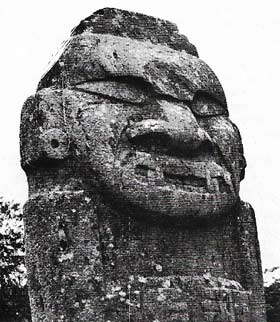 |
| Enigmatic and massive carvings are scattered on the hills round the present town of San Agustin in southern Colombia. Many depict men with spirit alter egos in the form of animals sitting on their heads and others combine human and feline features, with long fangs. There are megalithic chambers – possibly tombs – which are not unlike those of prehistoric Europe, with rock-cut basins and carved boulders. |
At the time of the Spanish Conquest, Colombia was occupied by large populations living in defended and palisaded settlements. Religion centred on sun-worship and the economy was based on potatoes and maize, and trade in salt, gold and emeralds.
The principal center in northern Peru was the basin of the River Moche, the seat of Mochica, Chima, Inca and Spanish colonial rulers. Mochc civilization dates from about AD 200 to about 700 and the resources its rulers could command are demonstrated by the colossal Temple of the Sun (Figure 1), a terraced pyramid 228 meters by 136 meters (741 feet by 442 feet) and 41 meters (133 feet) high, made of mud-adobe bricks, and the nearby Temple of the Moon, a palace complex adorned with wall paintings, as well as vast irrigation canals cutting across the desert. Some Moche cemeteries have been properly excavated, many others looted. The most notable furnishings are the stirrup-spouted jars (Figure 2), some with painted scenes of warfare, hunting and daily life, others modelled into three-dimensional portrait heads.
Palaces for life and death
From about AD 1000 onwards, the Moche valley held the capital of the kingdom of Chimor, the great city of Chan Chan, which covers more than 15.5 square kilometers (6 square miles) (Figures 6 and 7). The center of the city consists of ten basically similar walled enclosures, each with a maze of rooms and open courtyards and once rich but now looted tombs. It has been suggested that these were the successive palaces of the Chimil rulers, the new king building a new compound while his predecessor's was maintained in perpetuity as a funerary shrine. The tombs are known to have contained gold and silver vessels and jewelry, pottery and textiles.
On the central coast of Peru the "Lima style" of pottery suggests a state similar to Moche with ceremonial centres such as Aramburu, near present-day Lima. But the most spectacular pottery style was undoubtedly that of Nazca on the south coast, with polychrome vessels (Figure 3), often in four or five colours, and a dominant motif of a cat demon.
The most influential culture in southern Peru at that time, however, was based on Tiahuanaco, south of Lake Titicaca. Vast areas of ridged fields have been identified along the lake, indicating a large agricultural potential and the labor to exploit it. Tiahuanaco is noted for its monolithic stone carving, including the famous Gate of the Sun, which lies on one side of a large enclosure, and tall column statues in a stiff but detailed relief style. Tiahuanaco was preceded in the Andes by Pucara as a cultural centre and passed on some of its features to Huari, north of the lake.
 |
| Inca stone walls in the Peruvian Andes were constructed with quite remarkable skill, the hard stone blocks fitting closely together even though their outlines are irregular. One block in a Cuzco street has 12 angles, but such intricacy is not unusual. In Cuzco itself many Inca structures survive, including part of the Temple of the Sun. It now forms a section of the Dominican monastery. On the hills above Cuzco the great fortress of Sacsayhuaman presents its multiple ramparts to an enemy. Similar stonework is known at the mountaintop city of Machu Picchu and a version was used for agricultural terracing. |
Rise and fall of the Incas
Inca grandeur lasted for less than a century, from 1476 to 1534. Inca expansion began under the ruler Pachacuti Inca Yupanqui (reigned 1438–1471) and continued under his successor Topa Inca. At its peak it reached from Ecuador in the north, into what are now Chile, Bolivia and Argentina, running along the cordilleras of the Andes and the coast for more than 3,200 kilometers (2,000 miles), which left the Inca military over-extended. Much is known of Inca social and political organization – the system of recording information on knotted string quipus, the professional army, the communications by relays of runners, and the supreme authority of the Inca himself – the source of strength and ultimately the downfall of the empire.
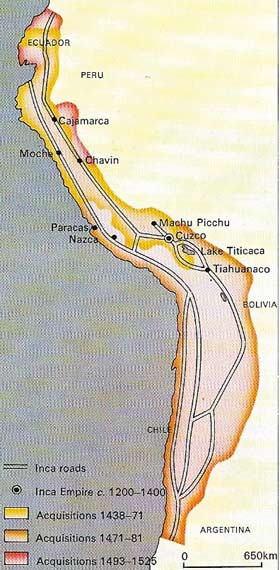 |
| The Inca Empire at the height of its power reached from northern Ecuador to the center of Chile, a distance of more than 3,200 kilometers (2,000 miles). The capital was at Cuzco, the homeland of the conquering Inca nation. From there the Inca himself was linked to the distant parts of his empire by a network of roads and messengers in foot relays. |
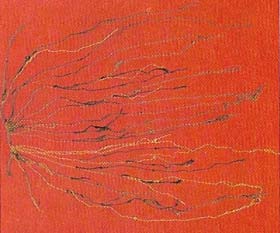 |
| A quipu, a series of knotted cords, was used by the Inca as a counting and memory device. The knots were of different colors to denote different kinds of numerical information and are an eloquent testimony to the bureaucratic structure of the Inca Empire. For recording the constant payments of incoming tribute they were indispensable. |
